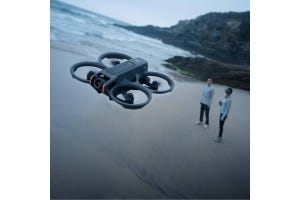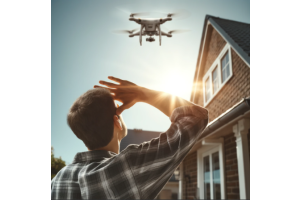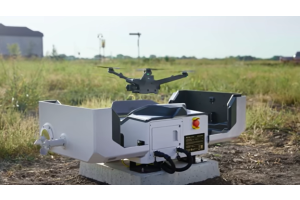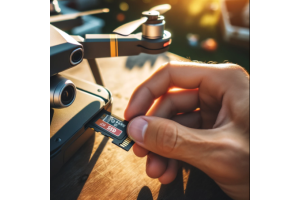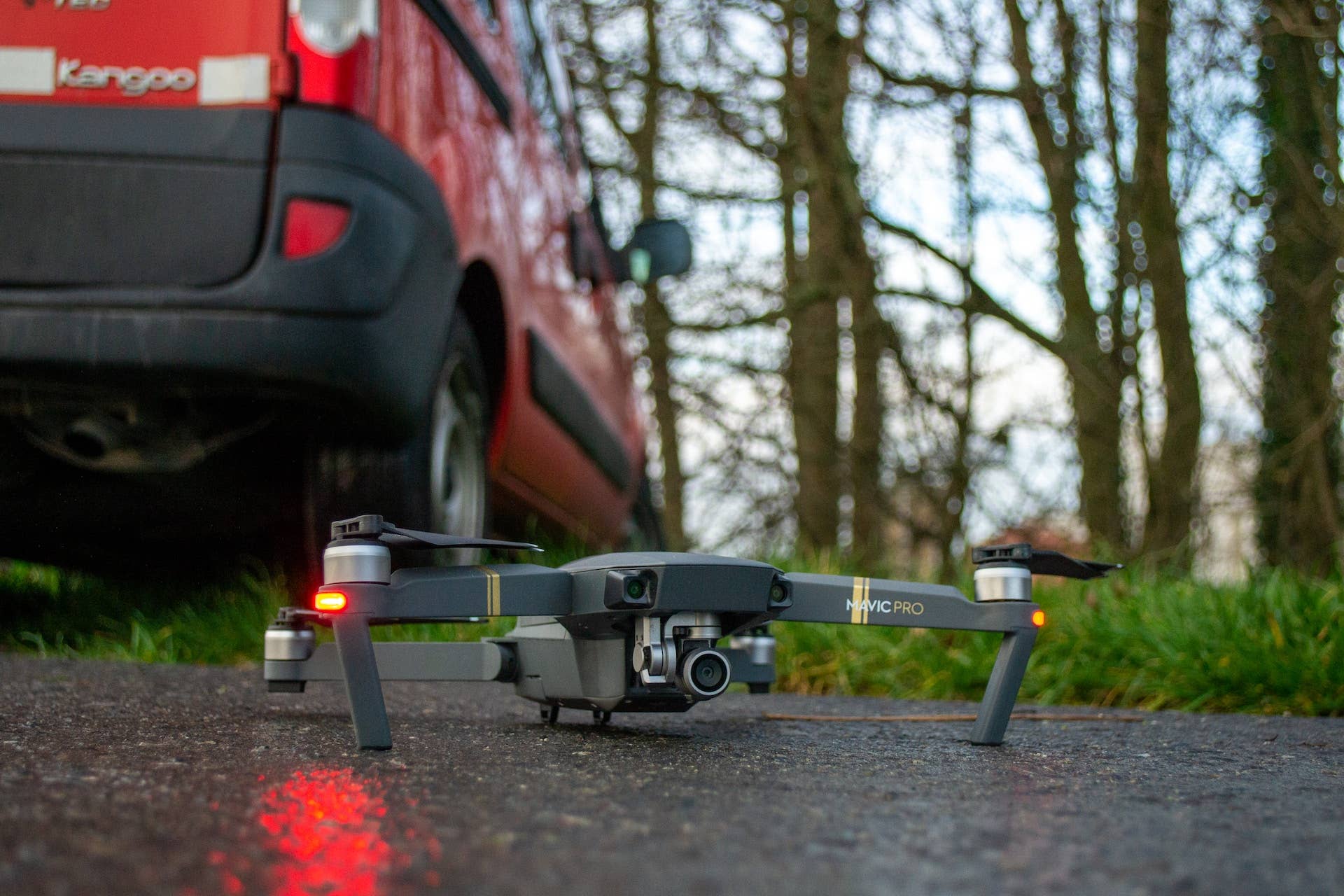
Every seasoned drone pilot understands the thrill of flying a drone and how important it is to find that ideal spot to take off and land. It's the beginning and end of our skyward-bound expeditions, and it plays a vital role in making sure our flights are safe and successful.
Selecting the right takeoff and landing site is not just a matter of convenience; it's a critical aspect of responsible drone operation. It can impact everything from the legality and safety of your flight to the overall quality of your aerial footage. By taking the time to carefully evaluate and choose the ideal location, you can enhance your flying experience and protect both your drone and the people around you.
So let’s dive into what you should weigh in when picking a spot:
8 Factors To Consider When Choosing A Takeoff And Landing Site For Your Drone
1. Legal and Regulatory Considerations
There are important legal and regulatory considerations that every drone enthusiast must keep in mind. Being aware of and abiding by the local drone laws and regulations is crucial to ensure a safe and responsible flight.
Familiarity with Local Drone Laws and Regulations
Before you take flight, take the time to familiarize yourself with the drone laws and regulations specific to your location. Different countries and even different states or provinces may have their own set of rules governing drone operations. These regulations typically cover aspects such as flight altitude limits, flying over crowds, and maintaining visual line of sight with your drone. Ignorance of the law is not an excuse, so make sure you're up to date on the latest regulations to avoid any legal trouble.
For instance, in the US, Recreational drone pilots follow the FAA's rules for model aircraft. On the other hand, commercial drone pilots must get certified and follow the FAA's Part 107 regulations.
Restricted Airspace and No-Fly Zones
Airspace is carefully managed to ensure the safety of manned aircraft, and there are designated no-fly zones where drone operations are strictly prohibited. These areas usually include airports, military installations, and other sensitive locations. To avoid unintentionally entering restricted airspace, you can refer to resources like the Federal Aviation Administration (FAA) or Civil Aviation Authority (CAA) for up-to-date information on no-fly zones in your region. Additionally, many drone manufacturers provide geofencing features in their drones to help prevent accidental flights into restricted areas.
Tip: The FAA and Aloft have collaborated to create a user-friendly mobile app called B4UFLY. This app helps recreational drone flyers by providing interactive maps that show them where they are allowed and not allowed to fly.
Watch how to use it here:
Airspace Classes
Here's a summary of the different classes of airspace and the general rules for drone operation in each.
- Class A: Class A airspace is for high altitude, controlled flight. It covers from 18,000 feet Mean Sea Level (MSL) up to and including Flight Level (FL) 600, which is approximately 60,000 feet. Only manned aircraft on Instrument Flight Rules (IFR) flight plans are allowed in this airspace. Drone operations are not allowed in Class A airspace.
- Class B: Class B airspace is generally airspace from the surface to 10,000 feet MSL surrounding the nation's busiest airports in terms of airport operations or passenger enplanements. Drone operators must get Air Traffic Control (ATC) permission to operate in this airspace.
- Class C: Class C airspace is generally airspace from the surface to 4,000 feet above the airport elevation (charted in MSL) surrounding those airports that have an operational control tower, are serviced by a radar approach control, and have a certain number of IFR operations or passenger enplanements. Drone operators must get ATC permission to operate in this airspace.
- Class D: Class D airspace is generally airspace from the surface to 2,500 feet above the airport elevation (charted in MSL) surrounding those airports that have an operational control tower. Drone operators must get ATC permission to operate in this airspace.
- Class E: Class E airspace is all controlled airspace that is not classified as Class A, B, C, or D. It includes airspace at various altitudes, and some of it is near airports, while some is not. Rules for drones in Class E airspace vary depending on the altitude and proximity to an airport, but often, drone operators must get ATC permission to operate in this airspace.
- Class G: Class G airspace is uncontrolled airspace that is not covered by Class A, B, C, D, or E. It is typically the airspace very close to the ground (1,200 feet or less), away from airports. Drone operators can fly in Class G airspace without ATC permission, but they must still follow all of the other FAA rules for drone operation, like not flying over people or beyond the visual line of sight, unless they have a waiver.
2. Safety and Accessibility
When it comes to flying your drone, safety should always be your top priority. Choosing the right takeoff and landing site is crucial to ensure a smooth and incident-free flight. Additionally, you need to consider the accessibility of the site to make your drone operation as convenient as possible.
Clear and Unobstructed Area for Takeoff and Landing
To start your drone flight on the right foot, you need a clear and unobstructed area for takeoff. Look for a spot that is free from trees, buildings, and other structures that could hinder the vertical ascent of your drone. Similarly, when it's time to land, a clear area ensures a safe and controlled descent. Remember, obstacles around the takeoff and landing site can pose a significant risk to your drone and those nearby, so always choose a location with ample space to maneuver.
Sufficient Space to Maneuver the Drone Safely
Once your drone is airborne, it needs enough space to move around freely. A cramped or confined area can limit your drone's maneuverability and increase the likelihood of collisions or accidents. Choose a location where you have sufficient room to navigate in all directions—forward, backward, left, and right. This will allow you to execute smooth aerial maneuvers, capture stunning footage, and maintain control over your drone throughout the flight.
We covered this and more in our video guide here:
Absence of People, Animals, or Other Potential Hazards
Safety is not just about the well-being of your drone but also the safety of those around you. Select a takeoff and landing site that is far away from crowded areas, people, and animals. Flying over populated areas can not only compromise privacy but also pose a risk to individuals on the ground. By choosing a location free from potential hazards, you minimize the chances of accidents or collisions and ensure a safe environment for everyone involved.
Open Fields or Designated Flying Areas
Open fields and designated flying areas are excellent examples of safe and accessible locations for your drone operations. These areas often provide a wide, open space with minimal obstacles, making them ideal for takeoff, landing, and maneuvering.
Additionally, designated flying areas usually have designated flight paths and guidelines, ensuring a safe and enjoyable experience for all drone enthusiasts. So, if you have access to these areas, take advantage of the safety and convenience they offer.
3. Environmental Factors
As a responsible drone pilot, you must consider the environmental factors that can significantly impact your drone's flight performance and overall safety. Understanding how weather conditions, wind speed and direction, and extreme temperatures can affect your drone will help you make informed decisions when choosing a takeoff and landing site.
Weather Conditions and Their Impact on Drone Flight
Weather conditions play a crucial role in determining whether it's suitable to fly your drone. Before taking off, check the local weather forecast to ensure optimal flying conditions. Strong winds, rain, snow, or fog can pose serious risks to your drone's stability and control. High winds, in particular, can make it difficult to maintain stable flight and may even cause your drone to drift away. Additionally, rain and snow can damage sensitive electronic components, so it's best to avoid flying in inclement weather.
- Wind Speed and Direction Considerations
Note the wind speed limitations specified by the manufacturer of your drone. Generally, it's advisable to avoid flying in windy conditions, especially if you're a beginner. If you do decide to fly in windy conditions, make sure to position yourself upwind from obstacles to maintain better control.
- Extreme Temperatures and Their Effects on Battery Life
Extreme temperatures, whether hot or cold, can impact the performance and lifespan of your drone's batteries. In cold temperatures, the battery's capacity may decrease, resulting in shorter flight times. On the other hand, high temperatures can cause the battery to overheat, leading to performance issues and potentially damaging the battery.
It's crucial to monitor the temperature range recommended by your drone's manufacturer and take necessary precautions, such as using insulated battery covers in cold weather or providing shade and airflow in hot conditions.
Let's say you're planning to fly your drone in an area known for its gusty winds or frequent rainstorms. In such situations, it's essential to exercise caution and choose a takeoff and landing site that offers shelter from the wind or rain. Consider flying in locations with natural windbreaks, such as buildings, trees, or hilly terrain, which can provide some protection against strong gusts. Similarly, find areas where you can avoid flying over bodies of water or low-lying areas prone to flooding during heavy rainfall.
4. Signal Interference and Connectivity
Ensuring a strong and reliable signal connection is crucial for a smooth and enjoyable drone flight experience. In this section, we will explore the factors related to signal interference and connectivity that you should consider when choosing a takeoff and landing site for your drone.
Evaluating Signal Strength and Potential Interference Sources
A weak signal can lead to video feed dropout, loss of control, or even a complete disconnection between your drone and the remote controller. Look for areas with clear line-of-sight to maintain a strong signal between your drone and the controller. If you notice a weak signal, it's best to avoid flying in that location or try relocating to a spot with better signal reception.
Additionally, be aware of potential sources of signal interference that can disrupt your drone's connectivity. Common sources of interference include power lines, radio towers, and other electronic devices. These can cause signal degradation and affect the overall performance of your drone. When selecting a takeoff and landing site, steer clear of areas with a high density of potential interference sources to minimize the risk of signal disruptions.
Avoid Areas with Electromagnetic Interference
Electromagnetic interference (EMI) can have a detrimental impact on your drone's signal and connectivity. EMI occurs when electromagnetic waves from external sources disrupt the radio frequency signals used by your drone and its remote controller. To ensure a stable and uninterrupted connection, avoid flying in areas with high EMI, such as industrial complexes, construction sites, or areas with heavy radio frequency usage.
Wi-Fi and GPS Connectivity Requirements
Most drones rely on Wi-Fi and GPS technologies for accurate positioning, navigation, and stable flight control. When choosing a takeoff and landing site, consider the requirements for Wi-Fi and GPS connectivity. Ensure that the area provides a good Wi-Fi signal, especially if you plan to use features like live streaming or automatic flight modes that rely on internet connectivity.
For GPS-enabled drones, it's important to have a clear view of the sky to ensure accurate satellite reception and reliable positioning. Urban areas with tall buildings or densely forested areas may hinder GPS signals, leading to imprecise positioning and potential flight instability. Opt for open spaces or areas with a clear view of the sky to maximize GPS signal reception and enhance flight performance.
Let's say you're excited to fly your drone near a picturesque park located in a crowded urban area. In such cases, it's crucial to be mindful of the potential signal interference from nearby power lines and the density of electronic devices in the area. Power lines can emit electromagnetic fields that interfere with your drone's signal, leading to poor connectivity and decreased control. Similarly, crowded urban areas with numerous Wi-Fi networks and electronic devices can create a challenging environment for maintaining a stable signal connection. In such scenarios, it's advisable to relocate to a spot farther away from power lines or find a less congested area to ensure optimal signal strength and connectivity.
5. Terrain and Surface Conditions
Before launching your drone, it's essential to evaluate the stability and flatness of the landing surface. A stable surface provides a solid foundation for takeoff and landing, reducing the risk of your drone tipping over or getting damaged. Avoid areas with loose soil, soft ground, or surfaces prone to erosion, as they may compromise your drone's stability during critical moments. Opt for solid ground such as pavement, grassy fields, or hard-packed dirt that can support your drone effectively.
Avoid Areas with Tall Grass, Trees, or Uneven Ground
Tall grass, dense shrubs, or overhanging branches can obstruct the drone's propellers and compromise its flight path. Uneven ground, such as rocky or hilly areas, can make landing and takeoff challenging, increasing the chances of a crash or damage to your drone. Choose locations with clear, open spaces that provide ample clearance around the drone and minimize the risk of tangling with vegetation or encountering obstacles.
Impact of Surface Conditions on Takeoff and Landing Precision
The surface conditions of your chosen site can have a significant impact on the precision of takeoff and landing maneuvers. For example, sandy beaches present unique challenges due to the shifting nature of sand. Soft sand can make it difficult for your drone's landing gear to gain traction and may lead to instability during takeoff or landing. Similarly, rocky terrains can pose risks such as propeller damage or loss of control if the drone collides with uneven surfaces. Whenever possible, opt for well-maintained surfaces that provide a stable and predictable environment for takeoff and landing.
6. Privacy and Public Perception
As responsible drone operators, it's important for us to be mindful of privacy considerations and public perception when choosing a takeoff and landing site.
Respect for Privacy and Avoiding Intrusion on Private Property
Avoid flying over private property without obtaining proper permission. Be aware of local laws and regulations regarding privacy rights and restrictions on aerial photography or videography. By respecting people's privacy and refraining from intruding on private spaces, you demonstrate responsible drone operation and maintain a positive image for the drone community as a whole.
Be Mindful of Bystanders and Potential Concerns
Drones can capture attention and curiosity, so it's essential to operate your drone in a considerate manner. Avoid flying too close to groups of people or crowded areas to minimize any perceived risks or discomfort. By maintaining a safe distance and respecting others' personal space, you create a positive experience for both yourself and those around you.
Communicate with People in the Vicinity
This can go a long way in addressing any concerns or questions from individuals in the vicinity. If you plan to fly your drone in an area where there might be people nearby, consider politely informing them about your activities and assuring them that you prioritize safety. Answer any questions they may have and explain your intentions. By fostering open and respectful communication, you can build understanding and alleviate any potential worries.
7. Distance and Accessibility to Subject or Points of Interest
How close and accessible are what you wish to capture? Let's explore the key factors that will help you make the most of your drone's purpose and achieve optimal flight paths.
Evaluate the Proximity to Areas of Interest for Your Drone's Purpose
Whether it's a stunning landscape, a historical landmark, or wildlife in its natural habitat, being close to your subject allows you to capture detailed and captivating footage. Consider the range and limitations of your drone's camera and plan your takeoff and landing site accordingly to maximize the potential for capturing breathtaking imagery.
Adjusting Takeoff and Landing Sites for Optimal Flight Paths
To achieve the best flight paths and angles for your shots, it may be necessary to adjust your takeoff and landing sites strategically. By selecting sites that provide clear lines of sight and unobstructed views of your subject, you'll have greater control over the composition of your shots. Keep in mind any potential obstacles such as trees, buildings, or other structures that could interfere with your flight path. By carefully planning your takeoff and landing sites, you can enhance the quality and creativity of your aerial photography or videography.
Transport Logistics for Reaching Remote Areas
Sometimes, capturing those extraordinary shots requires venturing into remote or hard-to-reach locations. When planning your drone flight, consider the transportation logistics necessary to access these areas. Evaluate factors such as road conditions, hiking trails, or any other means of reaching your desired location safely. It's crucial to ensure that you have a clear understanding of the accessibility and any potential limitations of the area, so you can plan accordingly and make the most of your drone's capabilities.
Say you have your sights set on capturing stunning aerial photographs of iconic landmarks or tracking the movements of wildlife in their natural habitats. Being in close proximity to landmarks allows you to capture intricate details and unique perspectives that would otherwise be challenging to achieve. Similarly, when tracking wildlife, being within a reasonable distance minimizes disturbance and ensures you capture their natural behaviors. By carefully choosing your takeoff and landing sites, you can position yourself optimally for extraordinary shots and remarkable footage.
8. Emergency Preparedness
Emergencies can happen when you least expect them, and it's essential to be prepared for any unforeseen events or contingencies while flying your drone. By incorporating emergency preparedness into your flight planning, you can mitigate risks and ensure the safety of both your drone and those around you. Let's take a look at some key considerations in this crucial aspect of drone operation.
Get Familiar with Emergency Procedures and Safety Equipment
Being well-versed in emergency procedures and having the necessary safety equipment at hand can make a significant difference in handling unexpected situations. Familiarize yourself with the emergency guidelines provided by your drone manufacturer and regulatory authorities. These guidelines often include instructions on what to do in case of a flyaway, a sudden loss of control, or any other emergency scenario.
In addition to knowing the procedures, make sure you have the essential safety equipment readily available. This may include fire extinguishers, safety cones or tape for marking off the area, and a first aid kit. Having these items on hand can help you respond swiftly and effectively in case of an emergency.
Plan for Contingencies and Unexpected Events
No matter how well you plan your drone flights, unexpected events can still occur. It's important to anticipate potential contingencies and have backup plans in place. Consider factors such as sudden changes in weather conditions, equipment failure, or unexpected flight restrictions. By having alternative flight paths or backup sites in mind, you can quickly adapt to changing circumstances and ensure a safe flight.
Additionally, staying informed about the latest weather updates and forecasts can help you make informed decisions about whether it's safe to fly. Check reliable sources, such as the National Weather Service or local meteorological services, to obtain accurate and up-to-date information. Remember, it's always better to postpone your flight than to risk flying in unsafe conditions.
Communication and Identification Measures for Lost Drones
Despite taking all the necessary precautions, there's still a possibility that your drone may become lost or unresponsive during a flight. To increase the chances of recovering your drone, it's crucial to establish effective communication and identification measures.
One helpful step is to label your drone with your contact information. Attach a tag or label that includes your name, phone number, and email address. This way, if someone finds your lost drone, they can easily reach out to you and facilitate its return.
Additionally, consider using a drone tracking device or software that allows you to monitor your drone's location in real-time. These devices can provide valuable information for recovery efforts and help you locate your drone more quickly.
Carrying a first aid kit during your drone flights is a wise precautionary measure. Accidents can happen, and having basic medical supplies readily available can make a significant difference in responding to injuries. Include items such as bandages, antiseptic wipes, scissors, and any other necessary supplies in your kit.
Furthermore, don't forget to bring emergency contact information with you. Have a card or note in your kit that includes emergency phone numbers, such as local authorities, nearby hospitals, and your personal emergency contacts. In case of an emergency involving you or someone nearby, having this information readily accessible can help expedite the response and ensure timely assistance.
Final Thoughts
Throughout this guide, we've explored various factors that can significantly impact your drone flights. We started with legal and regulatory considerations, highlighting the importance of familiarizing yourself with local drone laws, restricted airspace, and obtaining necessary permissions or permits for specific locations. Safety and accessibility were also key, emphasizing the need for clear, unobstructed areas, ample maneuvering space, and the absence of potential hazards.
As you embark on your drone-flying adventures, keep in mind that thorough research, careful planning, and adaptability are key to success. Take the time to gather information about your intended flight location, assess the potential risks and challenges, and create a well-thought-out flight plan. Stay informed about changing weather conditions, updates in local regulations, and any other relevant factors that may impact your flights.
Remember, the more prepared you are, the more enjoyable and rewarding your drone flights will be. So, keep exploring, honing your skills, and embracing the possibilities that drone technology offers.
Safe skies and happy flying!

